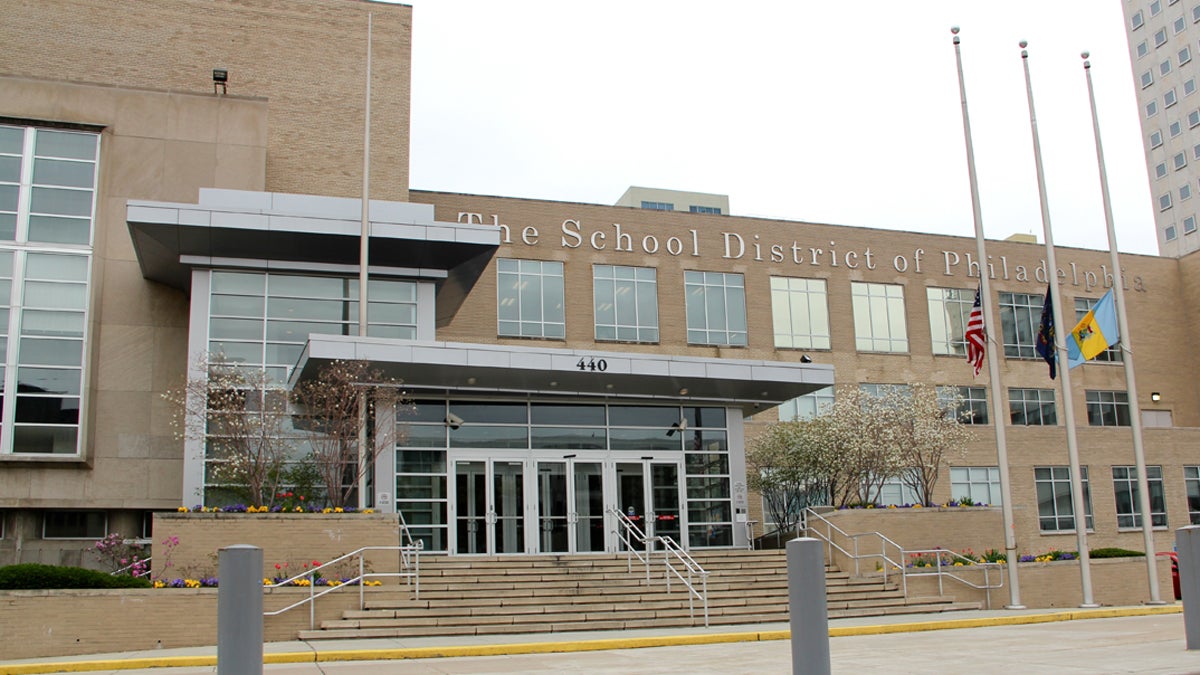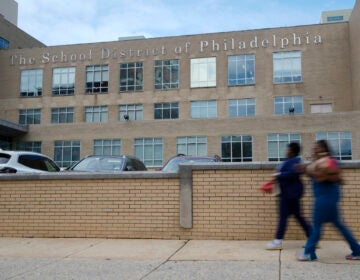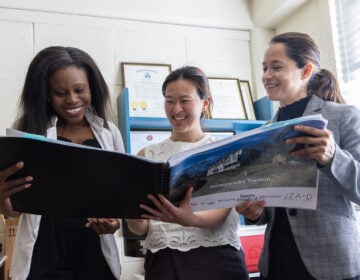Philly’s bid to outsource substitute teachers falters through first week of classes
Listen
Philadelphia School District headquarters at Broad and Spring Garden streets. (Emma Lee/WHYY)
The Philadelphia School District’s push to outsource substitute teaching services has thus far been a major disappointment.
The Cherry Hill based Source4Teachers promised to fill 90 percent of absences, but it’s rate through the first week of school hasn’t come close.
Finding enough subs has been a problem in the district for years, where the fill-rate averaged about 60 percent. It was that number that pushed district leaders to ink a $34 million contract in June with Source4Teachers.
That group promised to lift the fill-rate to more than 75 percent on day one of classes and 90 percent by January.
But, after a week of classes with the private firm in charge, district officials say they are “concerned.
The fill-rate has plummeted to just 11 percent — alarming principals across the district.
“I’m hopeful that the percentage increases dramatically next week, because it’s been a challenge this week,” said Tim McKenna, principal of Central High School, a magnet school that typically has been able to cover 100 percent of its absences.
On Friday, the school had seven absences and zero subs to cover, which means other teachers had to scramble.
So was outsourcing a bad idea?
“That’s basically above my pay-grade. I know that they’ve partnered with this company because they have a great track record in other districts,” said McKenna. “I’m trying to remain optimistic, and hopefully they come through like they’ve promised.”
Source4Teachers says it needs 5,000 subs on standby to cover Philadelphia classrooms when absences peak at 1,000 per day.
Despite a major marketing push, the firm only has 300 signed up, and — confounding them — even many of those haven’t been jumping to fill openings.
By January, if the outside firm doesn’t reach a 90 percent fill-rate, it will face financial penalties.
Will Source4Teachers make it?
“I’m not in a position to speculate on that,” said company spokesman Owen Murphy. “My hopes and intentions are certainly that we’ll make that number.”
An additional 600 applicants are in the process of joining Source4Teachers, according to Murphy.
The firm manages substitutes in more than 200 districts across the country, with Philadelphia as its largest contract.
Pay scale
Some teachers attribute Source4Teachers’ early struggles to the year-to-year differences in substitute pay.
For subs with little experience, Source4Teachers is currently offering better pay than the district had.
Where the district offered a $75 per diem to certified teachers and $48 for uncertified teachers, Source4Teachers pays $90 to $110 for those with certification, and between $75 and $90 for substitutes lacking certification.
For those with 22 days or more experience, the old deal was better. The district had been offering $127 for uncertified subs and $160 for credentialed subs.
Source4Teachers pays those same teachers between $100 and $140.
Retired teachers have particularly less incentive to join the privatized system. After earning $243 daily under the old scale, they’d, too, max out at $140 with Source4Teachers.
“I really couldn’t say whether the daily rate is the issue here,” said school district spokesman Fernando Gallard.
Philadelphia Federation of Teachers President Jerry Jordan disagreed.
“These are professionals. When you look at rate of pay Source4Teachers are paying them, it’s barely above minimum wage for a professional,” said Jordan. “If they’re going to work for those wages, they can do that in a number of places that are a lot less challenging than working as a teacher.”
In the past, the district encouraged retirees who had taught in hard-to-staff-schools to substitute in them by offering a higher rate.
After a state audit, the district was ordered to curtail that practice. They first had to offer sub positions to certified teachers; then to uncertified, and only to retirees as a last resort — who collected per diems in addition to their pensions.
In the wake of the Great Recession, in an attempt to save money, the district stopped hiring retiree substitutes — a move union officials blame for the lower fill-rate in recent years.
Retirees are now free to substitute through Source4Teachers at the lower per diem.
Jordan said the union has not actively dissuaded any of its retired members from doing so.
“We haven’t done that, we certainly know that people need to eat and feed their families and pay their bills,” said Jordan. “We’re fighting the district’s outsourcing of substitute teacher positions. We’d rather fight the district than put the blame on members who had nothing to do with this.”
Jordan particularly faulted Source4Teachers for not better filling substitute positions related to maternity leave and long-term disability.
Prior to this year, those positions were filled early and subs were given the ability to set up classrooms and integrate with the staff, Jordan said.
“That did not happen this year,” he said. “A number of schools don’t have the people.”
In addition to the district’s vacancies due to absences, it still has 99 positions that have remained unfilled.
Philadelphia Public School Notebook contributing editor Dale Mezzacappa contributed to this story.
WHYY is your source for fact-based, in-depth journalism and information. As a nonprofit organization, we rely on financial support from readers like you. Please give today.





